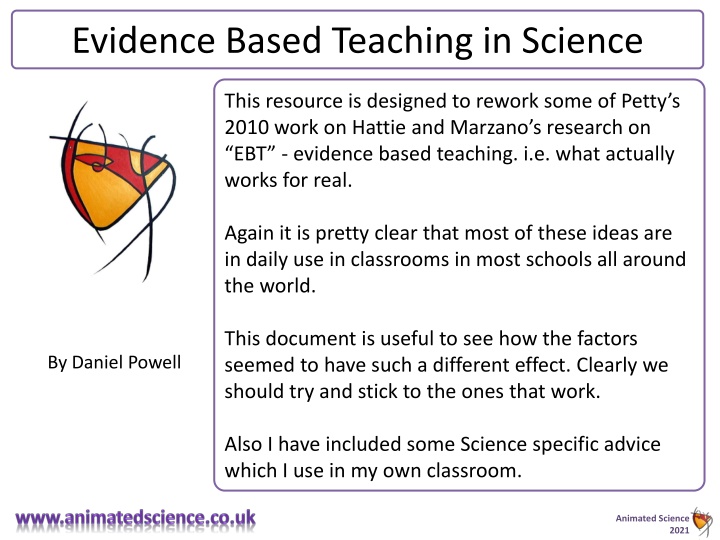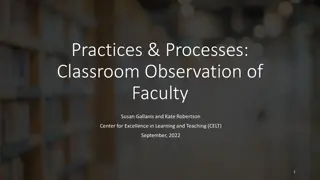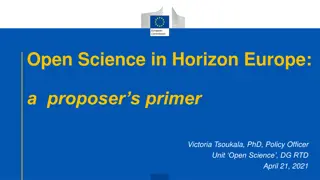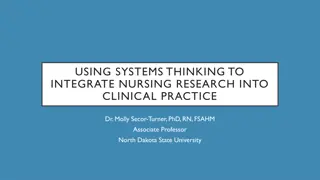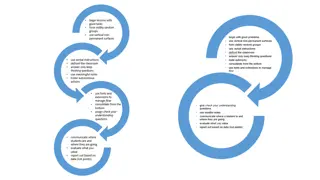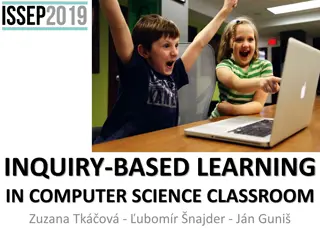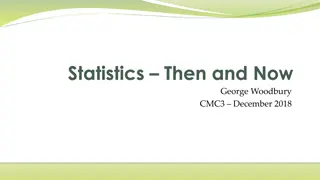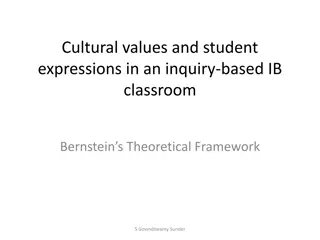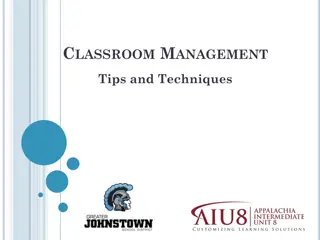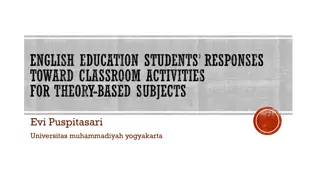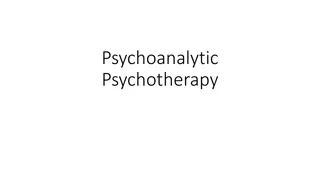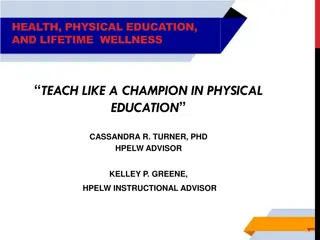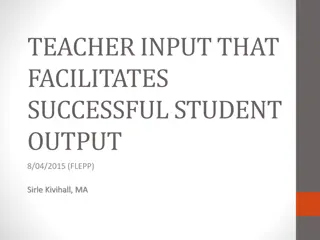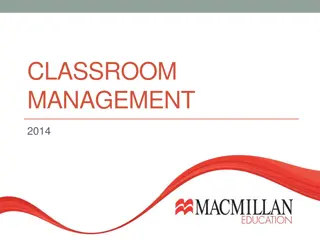Evidence-Based Teaching in Science: Reworking Research for Effective Classroom Practices
This resource delves into evidence-based teaching in science, drawing from the works of Hattie, Marzano, and Powell. It emphasizes the use of graphic organizers, cooperative learning, interactive teaching, and assessment for learning as effective methods. The research highlights key factors such as challenging goals, feedback, and tasks that require comparison and contrast, all essential for driving progress in educational outcomes.
Download Presentation

Please find below an Image/Link to download the presentation.
The content on the website is provided AS IS for your information and personal use only. It may not be sold, licensed, or shared on other websites without obtaining consent from the author.If you encounter any issues during the download, it is possible that the publisher has removed the file from their server.
You are allowed to download the files provided on this website for personal or commercial use, subject to the condition that they are used lawfully. All files are the property of their respective owners.
The content on the website is provided AS IS for your information and personal use only. It may not be sold, licensed, or shared on other websites without obtaining consent from the author.
E N D
Presentation Transcript
Evidence Based Teaching in Science This resource is designed to rework some of Petty s 2010 work on Hattie and Marzano s research on EBT - evidence based teaching. i.e. what actually works for real. Again it is pretty clear that most of these ideas are in daily use in classrooms in most schools all around the world. This document is useful to see how the factors seemed to have such a different effect. Clearly we should try and stick to the ones that work. By Daniel Powell Also I have included some Science specific advice which I use in my own classroom. Animated Science 2021
Evidence Based Teaching. Graphic Organisers are the best A lot of teaching research has taken place over the last 30 year on evidence based teaching . So now you are asking what do I mean by EBT ? It is really simple, you need to try and teach using methods which are the most productive. If you conduct a study and try and separate off each of the key methods to work out which one is best you get a indication of which one you should do more of. Two researchers Hattie, Marzano all did research into this area and then GeoffPetty published various documents which have been really useful to classroom teachers. Petty put together some of the ideas in 2010 to produce a really useful piece of work about Graphic Organisers . I have reworked his ideas to a more modern simple approach which applies mainly to teaching Secondary Science. Interactive Teaching 0.81 Hattie, J. (2009) Visible Learning. Routledge Graphic Organisers 1.3 Coop Learning 0.75 Marzano, R.J. et al (2001) Classroom Instruction that Works. ASCD, USA Teaching Strategies & Relative Value Reciprocal Teaching 0.86 Assessment for Learning 0.81 Petty, G. (2006) Evidence Based Teaching Nelson Thornes Manipulates 0.89 Animated Science 2021
Evidence Based Teaching. Driving Progress? Interactive Teaching 0.81 So what is the graphic about and all the numbers? Graphic Organisers 1.3 Coop Learning 0.75 The research done by Hattie and Marzano worked out that some methods which had a better teaching effect. They went through some complex trials with classes and double blind tests but overall they came out with pretty clear results. (see next slides) Teaching Strategies & Relative Value Reciprocal Teaching 0.86 Assessment for Learning 0.81 The scale is useful as we are looking for at least 0.5 as a factor and over 1 is a real winner. Manipulates 0.89 Value 0.1 Effect One really interesting factor was the negatives. (I have missed out the middle factors) but -0.78 for disruption is a massive issues. Which really shows why you need to get your behaviour policy working well. If not despite all the best interventions you try you will hold you head just below the waterline on your progress 8 figures. Normal annual maturation, no teaching Average effect of a teacher, regardless of quality Average effect of all educational interventions Equivalent to +1 grades as GCSE or A-level 0.25 0.42 0.5 0.8 Significant Effect, visible in class 1.0 Equivalent to +2 grades as GCSE or A-level Animated Science 2021
Marzano Research Key Factors. Ave Effect Size Rank Strategy SIMILARITIES AND DIFFERENCES Tasks that require students to compare and contrast. GRAPHIC REPRESENTATIONS 1 1.32 2 1.24 These include drawings, illustrations and annotated diagrams, but mostly Graphic Organisers. CHALLENGING GOALS 3 1.21 Challenges that require deep thinking and active learning. FEEDBACK (ASSESSMENT FOR LEARNING/FORMATIVE ASSESSMENT) 4 1.13 Students finding out what they have done well and what they need to improve. NOTE MAKING 5 0.99 Students creating personal and organised notes. Linked to peer explanation. RELEVANT RECALL QUESTIONS Questions designed to connect to students relevant prior knowledge. MANIPULATIVES (DECISIONS, DECISIONS) Students physically manipulate pre printed cards into different arrangements to represent their ideas. GENERATING AND TESTING HYPOTHESES Students have to use higher order, evaluative, thinking. Works very well with Assertive Questioning. COOPERATIVE LEARNING 6 0.93 7 0.89 8 0.79 9 0.78 Methods such as Jigsaw and Snowballing where students teach and check each others work. ADVANCE ORGANISERS 10 0.71 Giving students clearly organised summaries of what they are about to learn. Animated Science 2021
Hatties Research Key Factors. Rank Strategy Students studied Ave Effect Size WHOLE CLASS INTERACTIVE TEACHING A specific approach to active learning in class which is very teacher led but very active for students. Students and teachers get feedback throughout. RECIPROCAL TEACHING Strategy to help reading comprehension for students who find this difficult. It involves them in questioning, summarising, clarifying and predicting. FEEDBACK (ASSESSMENT FOR LEARNING/FORMATIVE ASSESSMENT) Students getting feedback on their work from the teacher, from themselves or from their peers. STRATEGY TRAINING Explicit teaching of a particular study or thinking skill. CLASSROOM BEHAVIOUR The influence of appropriate student behaviour on achievement. PRIOR ACHIEVEMENT The prior achievement of students in the class. OPEN V TRADITIONAL In primaries, working on own projects as opposed to whole class learning. SUMMER HOLIDAYS RETENTION Keeping students back and re doing a whole year again. TRANSFER OF SCHOOL DISRUPTIVE STUDENTS 1 1923 0.93 2 52 0.86 3 13209 0.81 4 7649 0.8 5 361 0.71 6 2094 0.71 80 3426 0.01 81 1923 0.06 82 3626 0.17 83 84 354 1511 0.26 0.78 Animated Science 2021
Graphic Organisers + 1.3 (over two grades) Interactive Teaching 0.81 Graphic organisers fall into four key categories and it is important to use the appropriate one. They are used to: Graphic Organisers 1.3 Coop Learning 0.75 Teaching Strategies & Relative Value Define (describe) Compare Sequence Cause and Effect Reciprocal Teaching 0.86 Assessment for Learning 0.81 Manipulates 0.89 Representing knowledge and ideas in visual format has one of the very highest scoring effect sizes. They are called graphic organisers because they organise information in a graphic fashion! By doing so, they by-pass the complexities of syntax. They offer the quickest and surest insight into students thinking and, as such, are powerful tools in formative assessment. Perhaps their greatest contribution is as frameworks for both dialogue and writing. In Science teaching a good mind map shows you what they know! Animated Science 2021
Key Categories - Explained Sequence: Anything logical in a pattern which is fixed. A flow bubble ads on extras.. Define: If you are trying to show ideas which closely linked, important or not so important or maybe a large amount of hierarchical ideas Compare: If you have some data with two variable which may have a link which new need to compare properties almost like a graph or plant and animal cell? Cause/ Effect: Something happens and then the spiders gives you what, which may be broken down further into many facets. Animated Science 2021
Main Key Organiser Types Animated Science 2021
Main Key Organiser Types Animated Science 2021
Manipulates + 0.89 (close to one grades) Interactive Teaching 0.81 Manipulatives are learning games that force the participants to reason and make decisions. Graphic Organisers 1.3 Coop Learning 0.75 They mainly involve the use of cards. In fact, they are rather like Graphic Organisers. But instead of the students drawing a diagram by choosing or remembering a series of linked words, the words are provided by the teacher. Teaching Strategies & Relative Value Reciprocal Teaching 0.86 Assessment for Learning 0.81 Manipulates 0.89 Pairs or groups of students manipulate the cards into different arrangements according to the task. Students have to agree by asking questions, explaining and making joint decisions. Tarsia puzzles are a really good example and they come in many forms. Ranking items with a criteria Sequencing Matching cards Grouping cards into 3 or 4 piles, then ranking Animated Science 2021
Reciprocal + 0.89 (close to one grade) Interactive Teaching 0.81 Originally designed for students with difficulty in understanding text, this technique is very powerful for all students. It develops understanding of content and also improves comprehension skill generally. Graphic Organisers 1.3 Coop Learning 0.75 Teaching Strategies & Relative Value The skills of understanding, summarising and asking appropriate questions were improved and transferred to different contexts. Students take it in turns to play the role of teacher and, as a result, they naturally adopt these higher order study skills. I think this is very useful for A-level students when reading through the textbook which you may assume they understand, when they have no idea! Reciprocal Teaching 0.86 Assessment for Learning 0.81 Manipulates 0.89 Questioning Summarising Clarifying Student leads the class in looking at a paragraph of text and asks questions to the other student Student now tries to summarise the section in a sentence or couple of words maybe a formula Teacher gives input back to the class on the paragraph overall and ensures everyone is clear Animated Science 2021
Interactive Teaching/ AfL + 0.81 (close to one grade) Interactive Teaching 0.81 A specific approach to active learning in class which is very teacher led but very active for students. Students and teachers get feedback throughout. A simple PAR Model may be used which allows a teacher to adapt as they go . Graphic Organisers 1.3 Coop Learning 0.75 Teaching Strategies & Relative Value Reciprocal Teaching 0.86 Assessment for Learning 0.81 Present Apply Review (the AfL part) Manipulate s 0.89 Elements of the lesson may include Note-making mindmap, poster or handout that summarises the key points. Class discussion organisers revisited and more detail added reviews at the beginning of a lesson with a short task Quizzes Tarsia cards Answering short review card Dice games with levelled questions Exam questions Animated Science 2021
Cooperative Learning + 0.75 Interactive Teaching 0.81 Cooperative learning promotes active learning. But, often teachers get bogged down in thinking about logistics which are only half the story. Graphic Organisers 1.3 Coop Learning 0.75 Teaching Strategies & Relative Value To make sure learning takes place, the focus needs to be on how students interrogate, understand and communicate the information they encounter. They must ask good questions and really engage for this to work. Reciprocal Teaching 0.86 Assessment for Learning 0.81 Manipulates 0.89 Jigsaw group work goes a long way to making this happen. Work is split into sections which are different for each group. Students have to explore, summarise and explain to each other and recombine in some form at the end of the lesson. You can also have experts move groups. Clearly this suits certain topics and subjects more than others. Climate change is a great example as people can take the roles of different sectors or jobs. Group Individual Responsibility Peer Group processing Social Skills Responsibility Interaction Animated Science 2021
